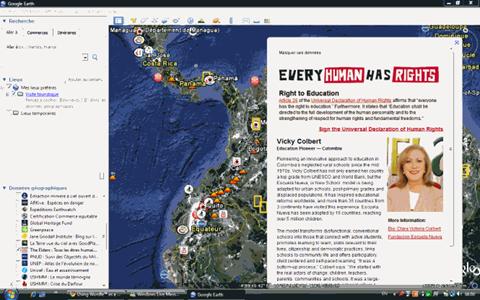Using Google Earth to Research Human Rights
Pamela AuCoin
Google Earth is a wonderful tool for students and teachers. It is an interactive, three-dimensional map which provides "layers" – a thematic set of data about the area you are studying. Imagine you are using an overhead projector and the film (or acetate) you are using is of a map. You want to show more information about this map, so you place a second acetate on top of the first. This is how Google Earth Layers works. Google Earth has a number of layers that you can choose from. In my class, I’m using the Global Awareness layer. With the global awareness layer option users can identify things such as: which regions are producing fair trade coffee; where Jane Goodall is helping chimpanzees; and which ecosystems are endangered – just to name a few.
For my unit on Human Rights Violations, I am currently working with "The Elders: Every Human Being Has Rights" sub-layer. When we select this sub-layer, Google Earth adds an icon for local human rights activist and organizations. Clicking on an icon shows where the activist organization is located, along with biographical information about the activist, and the opportunity to sign the United Nations Declaration of Human Rights.
As a history teacher, I'm aware that wars and crises take up a sizable chunk of the curriculum. By researching human rights activists, we're letting students know there are always other ways to fight injustice. After my unit on Human Rights Violations, my class discussed what is being done around the world to fight poverty, discrimination, and violence. One student found Stephen Bradberry of New Orleans, who is a Living Wage advocate. She read his biographic information, and was then provided a link to his organization. That link gives her to tools to get involved in fighting for those living in poverty in New Orleans.
Of course, they are also learning geography, by browsing the globe. Students begin to make important connections: Why would so many people in New Orleans need to fight poverty? By making connections to the recent ecological and natural disasters, students notice how geography and social problems can go hand-in-hand.

Getting Started:
- Go to website: http://google.com/intl/en/options
- Select “Earth” from the list of options in the column on the left
- Once you are on the Google Earth page, the blue button: "Dowload Google Earth 5" tab. This is free.
- After a brief download, the Google Earth window will open. You are ready to explore layers.
- In the Google Earth window, notice the tabs on the left: “Search,” “Places,” and “Layers.”
- Under the “Layers” tab, click the plus sign next to “Global Awareness” to reveal a drop down menu. Then select "The Elders: Every Human Has Rights"
- Explore the globe by manipulating the cursors. Click on desired regions which have the red and white "Every Human" icon. If you are working on a particular region, you can hone your exploration by entering that region in the “Search” tab
- Choose an icon to begin your research.
Further resources:
Amnesty International: http://amnesty.org
Students can research, join the mailing lists, and easily become active. Their "take action" program makes it easy to email their congress people, as well as governments around the world who violate human rights.
Human Rights Watch: http://hrw.org
The Whitehouse: http://whitehouse.gov
President Obama's team did a great job on the website, which is now more user-friendly than ever. I recommend having students contact the President through this site, to realize how easy it is to contact our highest elected official.
Do
you have a comment or suggestion? E-mail
Pamela
|